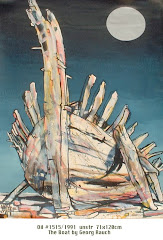I WAS INTERVIEWED FOR THE FOLLOWING ARTICLE WHICH APPEARED ON THE IUNIVERSE WEBSITE, IN COMMEMORATION OF NATIONAL HOLOCAUST WEEK - PHYLLIS RAUCH
Jew with the Iron Cross shows the realities of war
 | In times of war, things are not always black and white. That was the message of Georg Rauch, who was conscripted into Hitler’s army at eighteen and was sent to the Eastern Front where he experienced the horrors of war, the fierce Russian winter and won an Iron Cross before being captured and interned as a prisoner of war. Although Georg fought with the Wehrmacht, he was an unwilling participant, and what is perhaps more extraordinary was the fact that Georg was a quarter Jewish. And while he dodged mortar shells in the hell of the Russian war, at home in Vienna, his mother was risking all to protect the Jews that she had been sheltering in her attic. “His mother, Beatrix, was brilliant, cultivated, but, above all, a woman of courage and great moral fibre. Fully aware of how dangerous it was to hide the Jews in her attic, her sense of what was ethical and simply right would not have allowed her to do any differently,” said Phyllis Rauch, Georg’s wife, who is continuing to keep her husband’s memory alive after his passing. |
“Having known both Georg and his mother, I don’t think either of them wasted much time thinking about their difficult situations. Each of them concentrated on what was most important, helping the Jews and staying alive.” “Although Beatrix wasn’t a practicing Jew, she had Jewish friends, relatives, and forefathers. She became incensed when she saw Viennese street banners declaring ‘Might goes before Right’ and told her son that no moral person could possibly agree with such statements,” Phyllis said. Jew with the Iron Cross The Rauch family saga is told in Georg’s book, The Jew with the Iron Cross. Georg grew up in Vienna, and the reader cannot help but feel drawn to this character. “From earliest childhood, his mother had encouraged him to follow his fascination for painting, inventing, for using his brain and his imagination,” Phyllis said. The young Georg had a passion for building radios, teaching himself Morse code, cooking, and playing the harmonica. Little did he know that these skills would later help him survive the horrific situation on the Russian front. When he was drafted into service, he was immediately identified as officer material, and yet, when he admitted to his commanding officer that he was a quarter Jewish, he was instead sent to the front as a radio operator. His memoirs then record his ordeals, the pitiful rations, the piercing cold, and the violent battles and Georg’s struggles to stay alive. “Along the way, it became clear to him and early readers that a real war and its daily details is nothing whatsoever like Hollywood depictions. I think he would have liked for people to realize that history is often told in black and white, when the reality of a world war contains many different shades of gray,” his wife told iUniverse. “Readers are so used to heroes. Georg’s book has proven to many that the story of an average guy, doing his utmost to stay alive, can be much more fascinating than one more made-up heroic story.” Letters home The story of The Jew with the Iron Cross is partially told through a series of letters that Georg wrote home to his mother. These letters present the hardships of a young soldier at war and often provide details that no war movie could ever capture: the cold, the hunger, the despair. Perhaps protecting his mother from the truth, Georg’s letters never mention the fierce battles that he participated in or his many near misses, which he recounts in full detail throughout the book. In the end, the reader is able to see through the eyes of a young man forced to fight in a cause that he does not believe in. Poignantly, the letters home abruptly stop when Georg is captured by Russian troops and imprisoned in a POW camp, where the hardships and fight for survival continue. Fortunately, Georg managed to survive, although suffering from TB, and eventually he returned home. After a period of rehabilitation, he took up painting and enjoyed exhibits in Europe and beyond. He met and married Phyllis and immigrated to the United States before settling down in Mexico. The Jew with the Iron Cross has been met with rave reviews and is highly recommended to anyone with an interest in World War II, or who would like to learn more about Jewish soldiers in the Wehrmacht. It will also appeal to mothers whose sons are currently serving in the armed forces. | |



